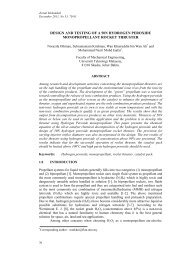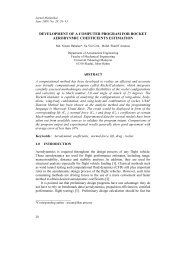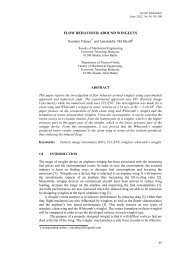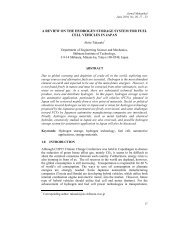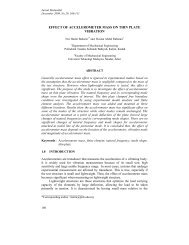Investigation of Gas Swirl Burner Characteristic ... - Jurnal Mekanikal
Investigation of Gas Swirl Burner Characteristic ... - Jurnal Mekanikal
Investigation of Gas Swirl Burner Characteristic ... - Jurnal Mekanikal
You also want an ePaper? Increase the reach of your titles
YUMPU automatically turns print PDFs into web optimized ePapers that Google loves.
<strong>Jurnal</strong> <strong>Mekanikal</strong> December 2011Figure 10 Model : <strong>Swirl</strong>er vane blades variation <strong>of</strong> 6, 8 and 10.3.2.2 Simulation and Experiment Results with New <strong>Gas</strong> <strong>Burner</strong>3.2.2.1 Results SimulationFigure 11 shows no significant difference in temperatures indicated by each type <strong>of</strong> swirlpossibly because the plane was only a few centimeters from the cones so that the flamethat formed possessed the same average temperature contours. Maximum temperaturewas approximately 900 o C for thermocouple 1 and 700 o C for thermocouple 2.(a)(b)Figure 11 : Temperature distribution for distance (a) X = 0.2 m (TC1) and (b) X=0.5 m(TC2)Temperature distribution as show in Figure 11 shows a high concentration <strong>of</strong>temperature near the middle area combustion unit, or in the radial direction. The graph onFigure 11a shows TC1 at x = 0.2 m, compared to TC2 at x = 0.5 m, gives highertemperature. Furthermore, TC1 indicates in the center <strong>of</strong> combustion unit, for <strong>Swirl</strong> 8, hasan interesting temperature distribution behavior. It shows that the distribution at thecenter does not reduce immediately, while for swirl vanes 6 and 10 shows the distributionin the center reduce immediately. It is possible, that the momentum <strong>of</strong> mixing process <strong>of</strong>swirl vanes 8 gives high enough kinetic reaction <strong>of</strong> combustion process.Predicted flame distribution shown in Figure 12 indicates that increasing theblade number strengthens the kinetic energy <strong>of</strong> the mixing process. High swirl numberstrengthens the kinetic reaction. But for swirl vane blades 8, the combustion process aftercones produces immediate combustion process, while for swirl vanes 6 and 10, givesdifferent results, namely, a late combustion process. This perhaps, presents a slowlykinetic reaction between gas and air near cones. The strength <strong>of</strong> swirl vanes 8 produces aflame with a high Re number.26



